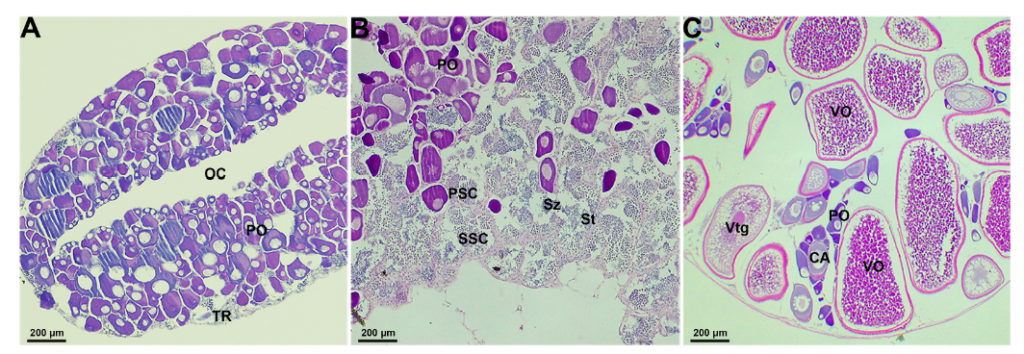Clownfish: Gonads and Transcriptomics
We’ve already covered the basics of reproductive life for anemone fish like Clark’s anemonefish. These fish live in social groups dominated by a single female that generally breeds exclusively with a single subordinate male. The rest of the group is comprised of non-breeding males. In the absence of a female, the males begin growing. Generally the subordinate male changes sex into the large dominant female, and the next largest male takes the position of the subordinate male. In this study (Wang et al., 2022), investigators wanted to explore the expression of genes related to sexual phenotype and how this is reflected in the anatomy of the gonads. The study of gene expression is generally termed transcriptomics. On this page, we will briefly cover their results and what this might tell us about sequential hermaphroditism in this species.
First, the researchers wanted to see what the gonads of fish looked like when expressing different sex phenotypes (Figure 1). What they found was that males have cells capable of making male gametes (TR testicular region in figure) and cells capable of making female gametes (PO primary oocytes, and OC ovarian cavity in figure). Non-breeding males (A) had many oocytes with a small testicular region at the periphery. Subordinate males (B) had a large testicular region with peripheral oocytes. This shows us that non-breeding males have the cellular architecture to produce either gamete, but have a small testicular region that reflects their non-breeding male role. Breeding males on the other hand still retain all the cells they need to produce female oocytes, but have a much more prominent testicular region that reflects their role as the only breeding male in the colony. However, none of the males were producing female gametes. They had female cells in waiting, but they were not active. Females (C) had only female sex cells. Once males transform into females, they lose all their male gamete-producing cells. The female then appears to be the terminal state. There is no switching back once a male has changed sex to the female phenotype.

We see that the gonads alone tell us a lot about the sex change process, but what about the genes? How are genes being regulated to coordinate this transition? The investigators isolated RNA from the fish gonads, then used reverse transcription and next-generation sequencing (NGS) to determine the relative levels of expression of various genes for different sex phenotypes. As expected, the researchers found that many of the genes involved in normal sex development were being manipulated in the animals to bring about sex change (Figure 2). Fish with different phenotypes showed different expression levels of sex-determination genes, and by changing these expression levels could bring about radical changes in their sex phenotype. This demonstrates that much of this process may be coordinated by changing expression of genes known to specify sex in vertebrates, and that sequential hermaphroditism could evolve through modifications of the existing and complex developmental systems already in place.

CLICK HERE to continue reading: Sex change in wrasse
Or navigate using the menu at the top this page